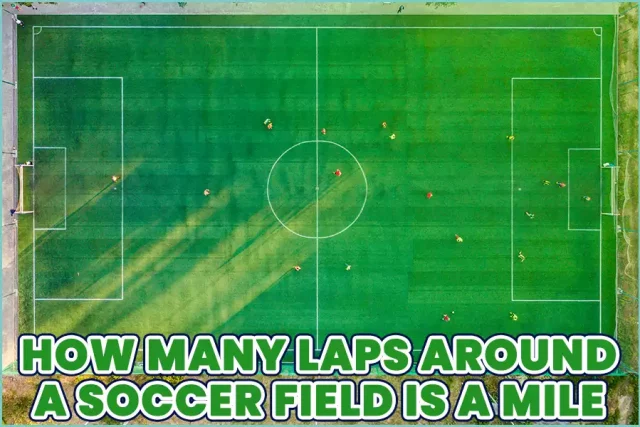Soccer is one of the most physically demanding sports worldwide. Therefore, soccer players need to be fully fit at all times. Why? The less fit players are, the higher their chances of underperforming or getting injured during games.
Every player must possess the stamina to make runs throughout matches. We have all seen how soccer teams whose players can press high and consistently for the entire 90 minutes won matches often.
There are diverse ways players can improve their physical fitness. And one of those ways is by running. Players do a lot of running during games, so there’s a need to improve stamina.
But then, how many laps can one do that equals a mile?
Let’s answer the question quickly.
How many laps around a soccer field is a mile?
When answering questions like these, you have to consider the size of the soccer field you’re evaluating.
Soccer fields are rectangular. But don’t forget that there’s a difference in size from one soccer field to another.
Now, let’s assume you plan on doing your laps on a soccer field measuring 360 feet long and 200 feet wide. In this case, 4.7 laps on the track area will give you a mile.
On the other hand, you can assume that 5 miles on a standard soccer field equal a mile.
Keep reading for more details on the subject.
Can Soccer Stadium Be Of Any Size?
Some stadiums are bigger than others. And you can have an idea of how big a soccer stadium is by its seating capacity.
The seating capacity implies the number of spectators that can watch a live match inside the stadium. And yes, stadium sizes may differ from one club to another.
For instance, FC Barcelona has one of the biggest stadiums worldwide. Their stadium is called the Camp Nou, with a 99,354 seating capacity.
So, in a stadium, clubs can make the stands (where people sit or stand to watch live matches) as big as their budget allows them. But they must adhere to FIFA, IFAB, and other relevant authority’s guidelines on safety.
Most clubs have even started expanding their stadiums in recent years for economic reasons. By the way, clubs also generate revenue from ticket sales.
But let’s not forget that while club owners can expand seating capacity whenever and if they so wish, it doesn’t apply to the play area.
The play area is where the match is played between the two teams of 11 players on each side. And the soccer fields have a standard size.
Now, let’s discuss what you need to know about soccer fields.
How Big Can A Soccer Field Be?
There are rules regarding the size of soccer fields, including how the game should be played.
The body responsible for making these rules includes FIFA (Federation International de Football Association) and IFAB (International Football Association Board).
IFAB is the body charged with deciding the laws of association football. And together with FIFA, it has decided what a standard soccer field’s size should be.
Firstly, the soccer governing bodies have agreed that soccer fields must be rectangular, which has been the case since its inception.
Now, let’s discuss the measurements of soccer fields.
The length:
Length may differ from one soccer field to another. But it mustn’t exceed the sports governing body’s guidelines.
IFAB and FIFA have agreed on a specific length for soccer fields.
Now, what’s the dimension of a soccer field? The recommended length is 100 to 130 yards (90 to 120 meters).
This means that the minimum length considered acceptable for a soccer field is 100 yards (90 meters), while the maximum is 130 yards (120 meters).
The width:
How wide can soccer fields be? FIFA and IFAB have also agreed that the standard width for soccer fields should be 50 to 100 yards (45 to 90 meters).
This range means that the minimum width of the soccer field is 50 yards (45 meters), while the maximum is 100 yards (90 meters).
All soccer fields must fall within this range. Otherwise, the governing bodies won’t approve them. If not approved, soccer fields can’t host competitions.
However, there’s no reason for any club or country to go against these guidelines. Such has never been the case since the inception of the sport.
The track area:
There’s also a track area marked with white color. This is where athletes run in the Olympics, not on the turf.
Also, a lot of sporting activities take place in the track area. Soccer players can do their running drills there too.
To better understand the soccer field, note that the turf is the play area. It’s where the game takes place. The track area is the marked area surrounding the play area.
However, the track area has 440 yards (400 meters). So, a revolution around the field and along the track is one lap. The revolution means running round the track without cutting corners.
So, if a player runs around the field on the track area, they would have covered a distance of 400 meters.
What Is The Turf Of A Soccer Field Made Of?
Soccer field turf contains natural grass. In the premier league, for example, the FA favors natural grass.
The grasses must also be green and flat and remain in good condition throughout the season. That’s what the football governing bodies want to see on the pitch.
However, everyone knows keeping a soccer field’s turf 100% natural grass throughout the season can be challenging. Nevertheless, many clubs try to achieve this.
So, clubs can either go 100% natural grass or use the hybrid grass system. And as the name implies, the hybrid grass system consists of natural grass combined neatly with artificial ones.
The artificial fibers combined with the natural grass help ensure premier league fields are always in top shape.
How Many Laps Should Soccer Players Run To Keep Fit?
Since the inception of the soccer game, laps have been a weapon in the hands of coaches to prepare players. Coaches use laps to warm up players before games or training.
Doing laps can benefit soccer players in diverse ways. First, it helps build the player’s endurance, something usually tested in matches.
The constant running trying to chase the ball or opponents can easily wear players down. But by leading players through the laps, coaches can prepare them to withstand whatever an opponent throws at them.
So, how many laps should players do to keep fit? Well, there’s no specific number of laps to maintain physical fitness.
Just do what works for you. And try to incorporate different exercises or patterns while doing your laps. For instance, you can dribble, strength train, or do a mile run, then stop for juggling.
The thing is incorporating other exercises while mile running is beneficial. How? It would make the exercise less boring and ensure you get the full benefits of what you’re doing.
Conclusion
So, how many laps around a soccer field is a mile? It is 5 laps for a standard soccer field.
The standard soccer field is 100 to 130 yards which equates to 90 to 120 meters long, and 50 to 100 yards, which equates to 45 to 90 meters wide.
Soccer players need to put themselves through the pace. Why? Doing more laps can prepare you to endure the physical demands of the sport.
You can see how many laps equal a mile. Now, it is time to plan your workout routines and run as many laps as you can to build fitness.














